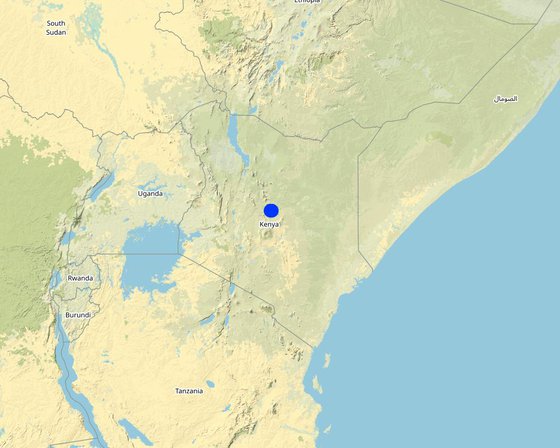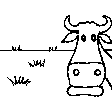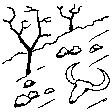



The 'Rangeland Restoration' technology is applied in degraded sites within the 3,100 Ha 'core conservation area' (an central area with minimised grazing pressure designated for tourism) and 'buffer zone' (an area surrounding the 'core conservation area' with reduced grazing pressure) of the Kalama Community Wildlife Conservancy (total area: 9,500 Ha).
The main characteristics are clearing of invasive woody vegetation (predominantly Acacia reficiens) and reseeding with grass (Cenchrus ciliaris). Acacia reficiens (commonly known as red-bark acacia, red thorn or false umbrella tree or thorn) is a native tree or shrub but is considered an invasive species as it can encroach degraded areas with bare and disturbed soil. It is very opportunistic and hardy and can subsequently take over large areas of native vegetation. The invasion can reach a closed or nearly closed canopy with A. reficiens thickets, which are hindering animals to enter and access fodder thus making the area inaccessible for grazing and browsing. Additionally it can be observed that the soil underneath the canopy remains bare and the grass growth seems to be suppressed. As a result the top soil is compacted or forms crusts, which hinder infiltration. During the erratic but heavy rains most of the water flows away as runoff (research in close by areas show that runoff is between 60-80 % of the rainfall) and increases soil erosion and further degradation of the land despite a rather good tree cover. Rangeland grass and fodder productivity in these areas are reduced to a fraction of their potential.
The main activity is the cutting of the trees and shrubs at a height of ~1 m. The main trunks and branches can be used for fencing, temporary house constructions, firewood and charcoal. Most of the cut trees and the remaining branches are used to spread on the bare land where the trees and shrubs are cut. Underneath this dead material the bare soil receives some cover, which creates favorable conditions and microclimate for termites and other fauna in the soil to brake the hard top soil and crust and enable infiltration of the water during the next rains. This allows regrowth of grasses, particularly in the areas protected by the branches. In the following seasons the spread of the grasses can increase also the the area not protected by the branches. Additionally, seeding with Cenchrus ciliaris (buffel-grass or African foxtail grass), a grass species which is native to most of Africa, enhances the growth of a highly valuable fodder grass. Seeds are hand-broadcasted in the treated areas and germinate during the next rainy season. The first greening is visible in the places where the branches and the wood pieces cover the soil. From there the local annual and perennial grasses start colonising and expanding in the following seasons until, ideally, the whole area that has been bare is covered by valuable perennial grasses. Parallel to the cutting and reseeding is reduced grazing pressure and a resting period over at least one dry season, which is facilitated by the fact that treated areas are situated in the core conservation area or in the buffer zone. This involves the cooperation of the members of Kalama Conservancy, who agree to restrict grazing in the buffer zone and more so in the core conservation area. The exact duration that grazing is allowed in each of these two areas varies year to year depending on drought severity and forage availability. Whereas the grazing pressure by livestock can be regulated, there remains uncontrolled grazing by wildlife. The major herbivores are zebra, elephants and a number of different gazelle and antelope species the grazing pressure by wildlife varies but can be substantial at certain times.
Rehabilitating degraded grazing land is the primary purpose of the technology. Other benefits of the technology include: 1) augmented forage availability for the community; 2) increased livestock production; 3) reduced soil erosion and flooding. Land users enjoy these benefits but would like larger areas to be similarly restored. However, the limiting factor is the funding required to pay for labour, which is the major input required for the clearing and reseeding activities. Establishing a market for removing the main stems and producing and selling charcoal is still an opportunity to further explore immediate benefits and cash income in order to pay for the investment into the clearing.

ສະຖານທີ່: Samburu County, ເຄັນຢາ
ຈໍານວນ ພື້ນທີ່ ທີ່ໃຊ້ ເຕັກໂນໂລຢີ ທີ່ໄດ້ວິເຄາະ: 2-10 ພຶ້ນທີ່
ການແຜ່ກະຈາຍຂອງເຕັກໂນໂລຢີ: ນໍາໃຊ້ໃນຈຸດສະເພາະ / ແນໃສ່ນໍາໃຊ້ໃນພື້ນທີ່ຂະໜາດນ້ອຍ
ຢູ່ໃນເຂດປ່າສະຫງວນທີ່ບໍ?:
ວັນທີຂອງການປະຕິບັດ: 2006; 10-50 ປີ ຜ່ານມາ
ປະເພດຂອງການນໍາສະເໜີ










| ລະບຸ ປັດໃຈ ນໍາເຂົ້າ ໃນການຜະລີດ | ຫົວໜ່ວຍ | ປະລິມານ | ຕົ້ນທຶນ ຕໍ່ຫົວໜ່ວຍ (Kenya Shillings) | ຕົ້ນທຶນທັງໝົດ ຂອງປັດໃຈຂາເຂົ້າ ໃນການຜະລິດ (Kenya Shillings) | % ຂອງຕົ້ນທຶນທັງໝົດ ທີ່ຜູ້ນໍາໃຊ້ທີ່ດິນ ໃຊ້ຈ່າຍເອງ |
| ແຮງງານ | |||||
| Clearing Acacia reficiens | person-days | 1200.0 | 450.0 | 540000.0 | |
| Hand-broadcasting Cenchrus ciliaris seeds | person-days | 1200.0 | 450.0 | 540000.0 | |
| ອຸປະກອນ | |||||
| Machettes | units | 40.0 | 500.0 | 20000.0 | |
| ວັດສະດຸໃນການປູກ | |||||
| Cenchrus ciliaris seeds | kg | 2520.0 | 50.0 | 126000.0 | |
| ອື່ນໆ | |||||
| Transport of workers to and from site | litre | 600.0 | 100.0 | 60000.0 | |
| ຕົ້ນທຶນທັງໝົດ ໃນການຈັດຕັ້ງປະຕິບັດ ເຕັກໂນໂລຢີ | 1'286'000.0 | ||||
| ຄ່າໃຊ້ຈ່າຍທັງໝົດ ສຳລັບການສ້າງຕັ້ງເຕັກໂນໂລຢີ ເປັນສະກຸນເງີນໂດລາ | 12'732.67 | ||||
due to degradation fodder production before was minimal both for grasses (hardly that survived the grazing pressure) as well as accessible browse material
perennial grasses were brought back
cut wood of the invasive species can be used for charcoal production, and construction material. The amount is high but the marketing is still weak, so most of it is left to be spread on the ground
one dominate invasive wood species was removed to give way for other native species to repopulate the area
There is still potential to decrease runoff further as the system is still recovering and improving.
damage on major bridges but also on smaller within the conservancy